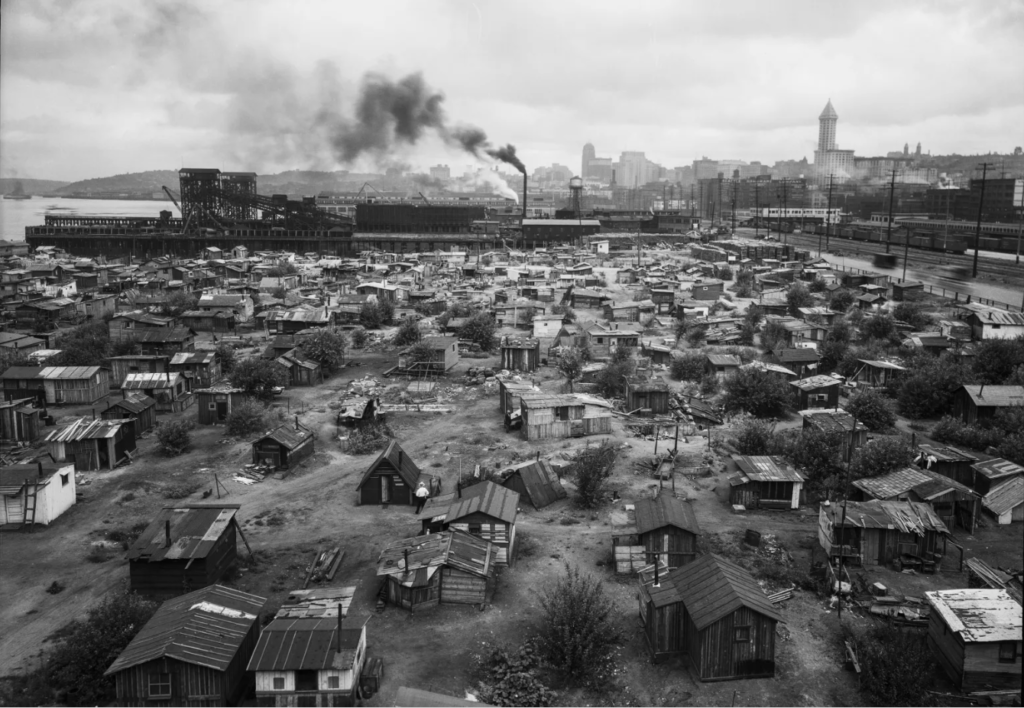
Seattle’s Waterfront Shantytown 1931 – 1941. Smith Tower is visible in the background on the right.
In the fall of 2010, the sponsors of a Seattle homeless encampment that had been moving from churchyard to churchyard were promised what they had always wanted, a long-term site on city land. For my Christmas column, I decided to write about another homeless camp, the original Hooverville.
My source for this column was a masters’ dissertation by a University of Washington student in the 1930s. The column ran in the Seattle Times of December 22, 2010.
Our Famous Homeless Camp
Nickelsville, Seattle’s much-publicized homeless camp, brings to mind a squatter camp of 79 years ago. It was Hooverville, named unfondly for President Herbert Hoover.
It grew on what now is Terminal 46 on Elliott Bay. In the fall of 1931, men went there to build shacks on bare ground. Twice the city burned them out, but in 1932, with the national jobless rate at 24 percent, the city let Hooverville stand. It stood for 10 years.
It was a settlement of adult men, 72 percent white. Two-thirds of the whites were foreign-born, mostly Scandinavians, Russians and Poles. One in five Hooverville residents was Filipino; the Philippines was an American colony then. The whites were mostly older than 40, and the Filipinos younger. There were also groups of African Americans and Mexicans. Few of these men had an education past the eighth grade.
The figures come from Donald Francis Roy, a sociology student at the University of Washington. In the spring of 1934, Roy moved to Hooverville to do his master’s thesis. It is a remarkable document.
Roy bought himself a shack for $15. That was a high price for Hooverville real estate; for $15 you could rent a house in Seattle for a month.
Roy’s shack, he wrote, had a bunk padded with burlap, with a comfort level “slightly superior to a sidewalk.” His stove was homemade. Few Hoovervillians had real woodstoves; most made theirs from 5-gallon kerosene cans, which leaked smoke.
Hooverville had two water faucets. A few men owned tubs large enough for a bath; others did their Saturday-night ablutions at the shelters. Hooverville’s latrines sat at the end of catwalks over the bay. The urinal was the ground.
Roy set out to interview the men. In hearing stories he inadvertently created one about himself. Because he would
disappear into older men’s shacks, some Hoovervillians thought he was engaged in prostitution. When some men announced their intention to “run all the punks out,” Roy switched to collecting statistics with survey cards.
His thesis, however, is more than statistics. It is a portrait — for example, of how they made a living. By 1934, about half the men were on relief. Some disdained welfare, and picked up cash by trolling for old newspapers, worth 40 cents a hundredweight. Some had odd jobs; in the summer, the Filipinos would leave for the canneries.
Some men just sat around and “palavered.” The drug of choice was “dehorn” — denatured alcohol. It was not good, and higher-caste Hoovervillians stayed away from it.
In many ways, maybe most ways, Hooverville was different from Nickelsville. The country has changed in 79 years. But one thing I note in the stories of Nickelsville is that the people there don’t like the elbow-to-elbow communalism of homeless shelters.
It was the same in the 1930s. Hooverville afforded privacy and, in Roy’s words, a “free and easy shanty life.”
Its mayor-by-acclamation, a lumberjack named Jesse Jackson, wrote in 1938 that “one of the reasons we came here was to get away from the relief organizations.”
Hooverville lasted until World War II. In March 1941, the month President Franklin Roosevelt signed the Lend-Lease Act — America’s economic declaration of war on Germany and Japan — the Seattle City Council ordered Hooverville bulldozed. The site became a U.S. Army terminal. It now supports Seattle’s container trade with Asia.
(© 2010 The Seattle Times)
Nearly a decade later, homelessness is an even bigger issue. Despite a booming economy, the “free and easy shanty life” has reappeared — not with wood and metal shacks, but with modern nylon tents.